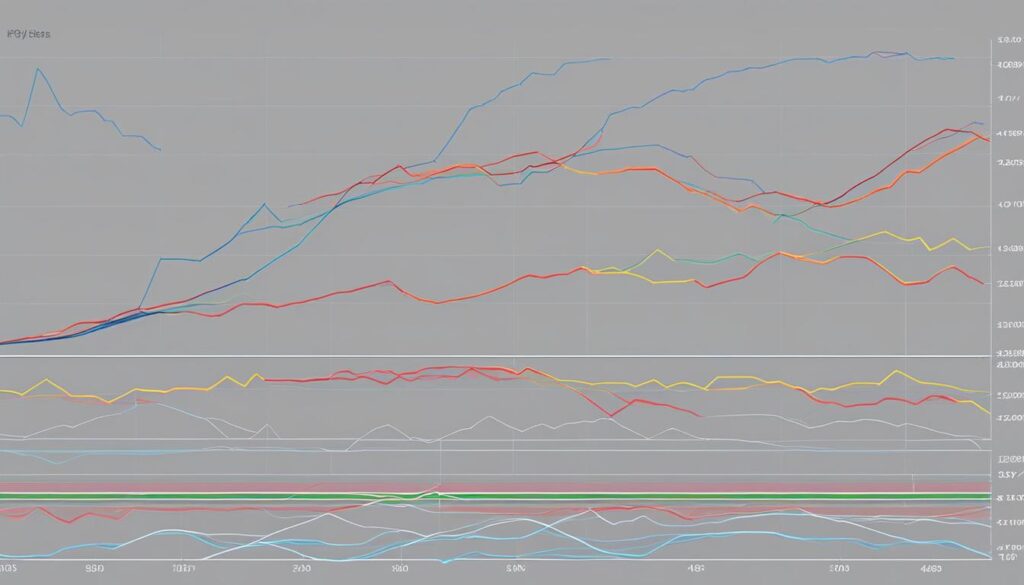Short selling with Contracts for Difference (CFDs) can be a powerful strategy for traders to profit from market downturns. By understanding the intricacies of short selling and leveraging the flexibility of CFDs, traders can navigate volatile markets with confidence and potentially generate profits from falling prices.
Short selling is a trading strategy that involves selling borrowed assets with the expectation that their price will decrease in the future. CFDs provide traders with a convenient way to engage in short selling without the need for physical ownership of the underlying assets. Instead, traders can enter into contracts that mirror the price movement of the assets, allowing for greater flexibility and accessibility.
Throughout this article, we will explore the fundamentals of short selling with CFDs, including how it works, effective trading strategies, and the benefits and risks involved. It is essential to understand the nuances of this strategy and employ proper risk management techniques to optimize your chances of success.
Join me as we delve into the art of short selling with CFDs and unlock the potential for profitability in market downturns.
Key Takeaways:
- Short selling with CFDs enables traders to profit from falling prices in the market.
- CFDs provide a convenient way to engage in short selling without the need for physical ownership of assets.
- Effective risk management is crucial when engaging in short selling with CFDs.
- Monitoring market trends and utilizing technical indicators can help identify short selling opportunities.
- Traders should always conduct thorough research and stay informed about market conditions.
What is Short Selling?
Short selling is a trading strategy that involves selling borrowed assets with the expectation that their price will decrease in the future. Traders aim to profit from this price decline by buying back the assets at a lower price and returning them to the lender. Short selling can be an effective strategy in bearish market conditions, allowing traders to profit from falling prices.
Short selling with CFDs provides traders with a convenient way to engage in this strategy. CFDs, or Contracts for Difference, are derivative products that allow traders to speculate on the price movement of an asset without actually owning it. Unlike traditional short selling that involves physically borrowing and delivering the underlying assets, CFDs allow traders to enter into contracts that mirror the price movement of the assets.
“Short selling is a powerful tool that can be used to profit from falling prices, but it requires a thorough understanding of market dynamics and proper risk management.”
By utilizing CFDs for short selling, traders can access a wide range of markets and assets, including stocks, currencies, commodities, and indices. This provides them with increased flexibility and opportunities to execute short selling strategies in different market conditions.
Benefits of Short Selling with CFDs:
- Opportunity to profit from falling prices
- Access to a diverse range of markets and assets
- Ability to execute short selling strategies with ease
- Potential for leveraging trading positions
Risks of Short Selling with CFDs:
- Market volatility and sudden price fluctuations
- Potential for unlimited losses if prices continue to rise
- Possibility of margin calls and forced liquidation
- Complexities of managing leveraged positions
It is important for traders to carefully consider the risks involved in short selling with CFDs and develop a comprehensive risk management strategy. This may involve setting stop-loss orders, diversifying their portfolio, and closely monitoring market conditions.
The next section will explore how CFDs work and provide more insight into the mechanics of short selling with these derivative products.
How Do CFDs Work?
CFDs, or Contracts for Difference, are derivative products that provide traders with the opportunity to speculate on the price movement of an underlying asset without owning it. When trading CFDs, I enter into a contract with a broker that mirrors the price of the asset. As the price of the asset changes, the value of the CFD also fluctuates, allowing me to potentially profit from price movements.
Traders have the flexibility to go long or short on CFDs, depending on their expectations for the price movement. Going long means expecting the price to rise, while going short means anticipating a price decline. Short selling with CFDs involves entering into a contract to sell the CFD at the current price and buying it back at a lower price in the future.
Here’s a breakdown of how CFDs work:
- Choose an underlying asset: Traders can choose from a wide range of assets, including stocks, indices, commodities, and currencies.
- Select the contract size: Traders decide the number of CFD units they wish to trade, which represents their exposure to the asset.
- Determine the leverage: CFDs offer leverage, which means I can control a larger position with a smaller amount of capital. The leverage ratio determines the multiplier effect on my potential profits and losses.
- Set the order type: Traders can place different types of orders, such as market orders (buy or sell at the current market price) or limit orders (buy or sell at a specific price).
- Monitor price movements: As the price of the underlying asset fluctuates, the value of the CFD will also change. Traders can monitor real-time price charts and use technical analysis tools to make informed trading decisions.
- Close the position: When I decide to close my CFD position, I simply enter into an opposite trade to the one I initially opened. If I went short, I would buy the CFD back at a lower price, realizing a profit. If I went long, I would sell the CFD at a higher price, securing my gains.
| Pros of trading CFDs | Cons of trading CFDs |
|---|---|
|
|
Overall, CFDs provide traders with a versatile trading instrument that can be used to capitalize on price movements in various markets. However, it’s important to remember that trading CFDs involves risks, and it’s crucial to have a solid understanding of the market, proper risk management strategies, and careful analysis before venturing into CFD trading.
Short Selling Strategies with CFDs
When it comes to short selling with CFDs, traders have a variety of strategies at their disposal. These strategies can help them identify potential opportunities, manage risk, and optimize their chances of success. By employing the right strategies, traders can navigate the complexities of CFD trading and potentially profit from falling prices.
Monitoring Market Trends
A popular approach to short selling with CFDs is to monitor market trends closely. By keeping a keen eye on the market, traders can identify assets that are likely to experience a price decline. This involves conducting thorough research and analyzing various factors, such as economic conditions, industry trends, and company performance. By staying informed, traders can spot potential short selling opportunities and execute their trades at the right time.
Utilizing Technical Indicators and Chart Patterns
Another effective strategy is to utilize technical indicators and chart patterns to identify potential short selling opportunities. Technical indicators, such as moving averages, MACD, and RSI, provide valuable insights into market trends and potential price reversals. Chart patterns, such as head and shoulders, double tops, and descending triangles, can also indicate potential price declines. By combining technical analysis with fundamental research, traders can enhance their short selling strategies and increase their chances of success.
Implementing Risk Management Techniques
Risk management is crucial when short selling with CFDs due to the inherent volatility of the markets. Prices can move quickly, and losses can accumulate rapidly. To mitigate these risks, traders should implement effective risk management techniques. This includes setting stop-loss orders to limit potential losses, establishing profit targets to secure gains, and having a well-defined exit strategy. By carefully managing their positions, traders can protect their capital and minimize the impact of adverse market movements.
In summary, short selling strategies play a vital role in CFD trading. By monitoring market trends, utilizing technical indicators and chart patterns, and implementing risk management techniques, traders can maximize their potential for success. However, it’s important to note that short selling involves risks, and traders should always conduct thorough research and adapt their strategies to market conditions. With the right approach and diligent risk management, short selling with CFDs can be a powerful tool for profiting from falling prices.
Benefits and Risks of Short Selling with CFDs
Short selling with CFDs offers several benefits to traders. It allows them to profit from falling prices, providing an opportunity to make money even during market downturns. CFDs also offer leverage, allowing traders to control a larger position with a smaller amount of capital.
However, short selling with CFDs also comes with risks. Market volatility can lead to significant price fluctuations, which can result in substantial losses. Traders need to carefully manage their positions, monitor market conditions, and always be aware of the potential risks involved.
“Short selling with CFDs can be a powerful strategy for traders to benefit from market downturns and falling prices. It offers the opportunity to generate profits in bearish market environments, which can offset losses in other positions and diversify trading strategies.” – Jason Scott, CFD Trader
Short Selling Benefits
- Profit from falling prices
- Opportunity to make money during market downturns
- Ability to diversify trading strategies
- Offset losses in other positions
CFD Risks
- Market volatility can lead to significant price fluctuations
- Potential for substantial losses
- High leverage can amplify losses
- Requires careful risk management and monitoring
It is important for traders to understand the benefits and risks associated with short selling using CFDs. By being aware of the potential rewards and dangers, traders can make informed decisions and implement strategies that align with their risk appetite and financial goals.
Conclusion
Short selling with CFDs can be a valuable strategy for traders seeking to capitalize on falling prices in the market. By understanding the fundamentals of short selling and implementing effective strategies, traders can confidently navigate market downturns and potentially generate profits.
However, it is important to acknowledge that engaging in short selling with CFDs carries inherent risks. Proper risk management is essential to mitigate potential losses and safeguard trading capital. To maximize their chances of success, traders should diligently conduct thorough research, stay informed about market conditions, and continuously refine their trading strategies.
With the right approach, short selling with CFDs can offer traders a powerful technique to take advantage of market opportunities and potentially achieve profitable outcomes even during challenging market environments. By staying disciplined, knowledgeable, and adaptable, traders can unlock the potential benefits of short selling with CFDs and navigate market downturns with confidence.
FAQ
What is short selling?
Short selling is a trading strategy that involves selling borrowed assets with the expectation that their price will decrease in the future. Traders aim to profit from this price decline by buying back the assets at a lower price and returning them to the lender.
How do CFDs work?
CFDs are derivative products that allow traders to speculate on the price movement of an underlying asset. When trading CFDs, traders enter into a contract with a broker that reflects the price of the asset. As the price of the asset changes, the value of the CFD also fluctuates. Traders can go long or short on CFDs, depending on their expectations for the price movement.
What are some short selling strategies with CFDs?
One popular approach is to monitor market trends and look for assets that are likely to experience a price decline. Traders can also utilize technical indicators and chart patterns to identify potential short selling opportunities. Risk management is crucial when short selling with CFDs, as prices can move quickly and losses can accumulate. Setting stop-loss orders and having a well-defined exit strategy is essential for managing risk in short selling.
What are the benefits and risks of short selling with CFDs?
Short selling with CFDs allows traders to profit from falling prices, providing an opportunity to make money even during market downturns. CFDs also offer leverage, allowing traders to control a larger position with a smaller amount of capital. However, short selling with CFDs also comes with risks. Market volatility can lead to significant price fluctuations, which can result in substantial losses. Traders need to carefully manage their positions, monitor market conditions, and always be aware of the potential risks involved.
Is short selling with CFDs a valuable tool for traders?
Yes, short selling with CFDs can be a valuable tool for traders looking to profit from falling prices. By understanding the basics of short selling and utilizing effective strategies, traders can navigate market downturns with confidence. However, it is important to remember that short selling with CFDs involves risks, and proper risk management is crucial. Traders should always conduct thorough research, stay informed about market conditions, and continuously refine their trading strategies to optimize their chances of success. With the right approach, short selling with CFDs can be a powerful technique for capitalizing on market opportunities.
Disclaimer
All information on this website is of a general nature. The information is not adapted to conditions that are specific to your person or entity. The information provided can not be considered as personal, professional or legal advice or investment advice to the user.
This website and all information is intended for educational purposes only and does not give financial advice. Signal Mastermind Signals is not a service to provide legal and financial advice; any information provided here is only the personal opinion of the author (not advice or financial advice in any sense, and in the sense of any act, ordinance or law of any country) and must not be used for financial activities. Signal Mastermind Signals does not offer, operate or provide financial, brokerage, commercial or investment services and is not a financial advisor. Rather, Signal Mastermind Signals is an educational site and a platform for exchanging Forex information. Whenever information is disclosed, whether express or implied, about profit or revenue, it is not a guarantee. No method or trading system ensures that it will generate a profit, so always remember that trade can lead to a loss. Trading responsibility, whether resulting in profits or losses, is yours and you must agree not to hold Signal Mastermind Signals or other information providers that are responsible in any way whatsoever. The use of the system means that the user accepts Disclaimer and Terms of Use.
Signal Mastermind Signals is not represented as a registered investment consultant or brokerage dealer nor offers to buy or sell any of the financial instruments mentioned in the service offered.
While Signal Mastermind Signals believes that the content provided is accurate, there are no explicit or implied warranties of accuracy. The information provided is believed to be reliable; Signal Mastermind Signals does not guarantee the accuracy or completeness of the information provided. Third parties refer to Signal Mastermind Signals to provide technology and information if a third party fails, and then there is a risk that the information may be delayed or not delivered at all.
All information and comments contained on this website, including but not limited to, opinions, analyzes, news, prices, research, and general, do not constitute investment advice or an invitation to buy or sell any type of instrument. Signal Mastermind Signals assumes no responsibility for any loss or damage that may result, directly or indirectly, from the use or dependence on such information.
All information contained on this web site is a personal opinion or belief of the author. None of these data is a recommendation or financial advice in any sense, also within the meaning of any commercial act or law. Writers, publishers and affiliates of Signal Mastermind Signals are not responsible for your trading in any way.
The information and opinions contained in the site are provided for information only and for educational reasons, should never be considered as direct or indirect advice to open a trading account and / or invest money in Forex trading with any Forex company . Signal Mastermind Signals assumes no responsibility for any decisions taken by the user to create a merchant account with any of the brokers listed on this website. Anyone who decides to set up a trading account or use the services, free of charge or paid, to any of the Broker companies mentioned on this website, bears full responsibility for their actions.
Any institution that offers a service and is listed on this website, including forex brokers, financial companies and other institutions, is present only for informational purposes. All ratings, ratings, banners, reviews, or other information found for any of the above-mentioned institutions are provided in a strictly objective manner and according to the best possible reflection of the materials on the official website of the company.
Forex/CFD trading is potentially high risk and may not be suitable for all investors. The high level of leverage can work both for and against traders. Before each Forex/CFD investment, you should carefully consider your goals, past experience and risk level. The opinions and data contained on this site should not be considered as suggestions or advice for the sale or purchase of currency or other instruments. Past results do not show or guarantee future results.
Neither Signal Mastermind Signals nor its affiliates ensure the accuracy of the content provided on this Site. You explicitly agree that viewing, visiting or using this website is at your own risk.




